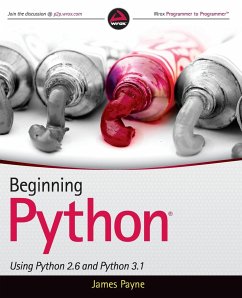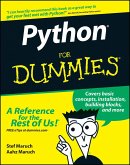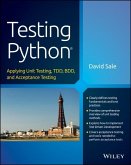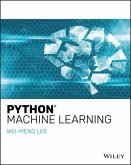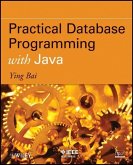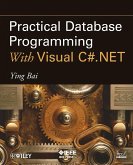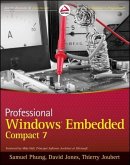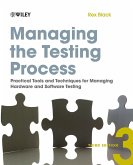James Payne
Beginning Python
James Payne
Beginning Python
- Broschiertes Buch
- Merkliste
- Auf die Merkliste
- Bewerten Bewerten
- Teilen
- Produkt teilen
- Produkterinnerung
- Produkterinnerung
Beginning Python: Using Python 2.6 and Python 3.1 introduces this open source, portable, interpreted, object-oriented programming language that combines remarkable power with clear syntax. This book enables you to quickly create robust, reliable, and reusable Python applications by teaching the basics so you can quickly develop Web and scientific applications, incorporate databases, and master systems tasks on various operating systems, including Linux, MAC OS, and Windows. You'll get a comprehensive tutorial that guides you from writing simple, basic Python scripts all the way through complex…mehr
Andere Kunden interessierten sich auch für
![Python for Dummies Python for Dummies]() Stef MaruchPython for Dummies28,99 €
Stef MaruchPython for Dummies28,99 €![Testing Python Testing Python]() David SaleTesting Python35,99 €
David SaleTesting Python35,99 €![Python Machine Learning Python Machine Learning]() Wei-Meng LeePython Machine Learning33,99 €
Wei-Meng LeePython Machine Learning33,99 €![Practical Database Programming with Java Practical Database Programming with Java]() Ying BaiPractical Database Programming with Java118,99 €
Ying BaiPractical Database Programming with Java118,99 €![Practical Database Programming with Visual C#.Net Practical Database Programming with Visual C#.Net]() Ying BaiPractical Database Programming with Visual C#.Net137,99 €
Ying BaiPractical Database Programming with Visual C#.Net137,99 €![Professional Windows Embedded Compact 7 Professional Windows Embedded Compact 7]() Samuel PhungProfessional Windows Embedded Compact 735,99 €
Samuel PhungProfessional Windows Embedded Compact 735,99 €![Managing the Testing Process Managing the Testing Process]() Rex BlackManaging the Testing Process36,99 €
Rex BlackManaging the Testing Process36,99 €-
-
-
Beginning Python: Using Python 2.6 and Python 3.1 introduces this open source, portable, interpreted, object-oriented programming language that combines remarkable power with clear syntax. This book enables you to quickly create robust, reliable, and reusable Python applications by teaching the basics so you can quickly develop Web and scientific applications, incorporate databases, and master systems tasks on various operating systems, including Linux, MAC OS, and Windows. You'll get a comprehensive tutorial that guides you from writing simple, basic Python scripts all the way through complex concepts, and also features a reference of the standard modules with examples illustrating how to implement features in the various modules. Plus, the book covers using Python in specific program development domains, such as XML, databases, scientific applications, network programming, and Web development. Note: CD-ROM/DVD and other supplementary materials are not included as part of eBook file.
Hinweis: Dieser Artikel kann nur an eine deutsche Lieferadresse ausgeliefert werden.
Hinweis: Dieser Artikel kann nur an eine deutsche Lieferadresse ausgeliefert werden.
Produktdetails
- Produktdetails
- Verlag: John Wiley & Sons / Wiley
- Seitenzahl: 624
- Erscheinungstermin: 2. Februar 2010
- Englisch
- Abmessung: 235mm x 191mm x 33mm
- Gewicht: 1151g
- ISBN-13: 9780470414637
- ISBN-10: 0470414634
- Artikelnr.: 26009592
- Herstellerkennzeichnung
- Libri GmbH
- Europaallee 1
- 36244 Bad Hersfeld
- gpsr@libri.de
- Verlag: John Wiley & Sons / Wiley
- Seitenzahl: 624
- Erscheinungstermin: 2. Februar 2010
- Englisch
- Abmessung: 235mm x 191mm x 33mm
- Gewicht: 1151g
- ISBN-13: 9780470414637
- ISBN-10: 0470414634
- Artikelnr.: 26009592
- Herstellerkennzeichnung
- Libri GmbH
- Europaallee 1
- 36244 Bad Hersfeld
- gpsr@libri.de
James Payne is Editor in Chief of www.developershed.com, a network of high-technology sites that serves millions of unique visitors every month who are seeking tutorials, advice, answers, or articles.
Introduction xxvii
Part I: Dipping Your Toe into Python 1
Chapter 1: Programming Basics and Strings 3
How Programming is Different from Using a Computer 3
The First Steps 5
Beginning to Use Python - Strings 7
Putting Two Strings Together 11
Putting Strings Together in Different Ways 12
Summary 13
Exercises 14
Chapter 2: Numbers and Operators 15
Different Kinds of Numbers 15
Program Files 18
Using Numbers 24
Summary 28
Exercises 29
Chapter 3: Variables - Names for Values 31
Referring to Data - Using Names for Data 31
Using More Built-in Types 34
Other Common Sequence Properties 43
Summary 47
Exercises 48
Part II: Python Language and the Standard Library 49
Chapter 4: Making Decisions 51
Comparing Values - Are They the Same? 51
Doing the Opposite - Not Equal 53
Comparing Values - Which One Is More? 54
Reversing True and False 56
Looking for the Results of More Than One Comparison 56
Repetition 60
Handling Errors 65
Summary 67
Exercises 69
Chapter 5: Functions 71
Putting Your Program into Its Own File 71
Functions: Grouping Code under a Name 73
Layers of Functions 88
Summary 89
Exercises 90
Chapter 6: Classes and Objects 93
Thinking About Programming 93
Defining a Class 96
Summary 107
Exercises 108
Chapter 7: Organizing Programs 111
Modules 112
Packages 118
Modules and Packages 120
Basics of Testing Your Modules and Packages 124
Summary 124
Exercises 125
Chapter 8: Files and Directories 127
File Objects 127
Paths and Directories 131
Exceptions in os 132
Summary 142
Exercises 142
Chapter 9: Other Features of the Language 143
Lambda and Filter: Short Anonymous Functions 143
Map: Short-Circuiting Loops 144
Decisions within Lists - List Comprehension 145
Generating Iterators for Loops 146
Special String Substitution Using Dictionaries 148
Featured Modules 149
Summary 156
Exercises 156
Chapter 10: Building a Module 157
Exploring Modules 157
Creating Modules and Packages 162
Working with Classes 163
Finishing Your Modules 166
Creating a Whole Module 179
Installing Your Modules 183
Summary 187
Exercises 188
Chapter 11: Text Processing 189
Why Text Processing Is So Useful 189
Navigating the File System with the os Module 192
Working with Regular Expressions and the re Module 199
Summary 203
Exercises 204
Part III: Putting Python to Work 205
Chapter 12: Testing 207
Assertions 208
Test Cases and Test Suites 209
Test Fixtures 213
Putting It All Together with Extreme Programming 216
Formal Testing in the Software Life Cycle 224
Summary 225
Chapter 13: Writing a GUI with Python 227
GUI Programming Toolkits for Python 228
Tkinter Introduction 229
Creating GUI Widgets with Tkinter 229
Summary 238
Exercises 238
Chapter 14: Accessing Databases 239
Working with DBM Persistent Dictionaries 240
Working with Relational Databases 245
Using the Python Database APIs 252
Summary 262
Exercises 263
Chapter 15: Using Python for XML 265
What Is XML? 265
What Is a Schema/DTD? 268
Document Type Definitions 268
Schemas 270
XPath 272
HTML as a Subset of XML 272
XML Libraries Available for Python 274
What Is SAX? 274
Why Use SAX or DOM 275
SAX and DOM Parsers Available for Python 276
Intro to XSLT 280
What Is lxml? 280
Element Classes 281
Parsing with lxml 283
Summary 285
Exercises 285
Chapter 16: Network Programming 287
Understanding Protocols 289
Sending Internet E-mail 293
Retrieving Internet E-mail 305
Socket Programming 314
Introduction to Sockets 314
Binding to an External Hostname 316
Other Topics 332
Summary 334
Exercises 335
Chapter 17: Extension Programming with C 337
Extension Module Outline 338
Building and Installing Extension Modules 340
Passing Parameters from Python to C 342
Returning Values from C to Python 345
The LAME Project 346
The LAME Extension Module 350
Using Python Objects from C Code 363
Summary 366
Exercises 366
Chapter 18: Numerical Programming 367
Numbers in Python 368
Mathematics 374
Complex Numbers 378
Arrays 380
Summary 384
Exercises 384
Chapter 19: An Introduction to Django 387
What Are Frameworks and Why Would I Use One? 388
Other Features of Web Frameworks 388
Django - How It All Began 389
Understanding Django's Architecture 390
Working with Templates 396
Using Templates and Views 398
Creating a Model: Creating an Application 403
Working with Models: Installation 404
Summary 405
Exercises 406
Chapter 20: Web Applications and Web Services 407
REST: The Architecture of the Web 408
HTTP: Real-World REST 411
CGI: Turning Scripts into Web Applications 417
HTML Forms' Limited Vocabulary 422
Safety When Accessing Form Values 423
Building a Wiki 428
Web Services 441
REST Web Services 442
XML-RPC 456
SOAP 465
Documenting Your Web Service API 472
Choosing a Web Service Standard 478
Web Service Etiquette 479
Summary 480
Exercises 480
Chapter 21: Integrating Java with Python 481
Scripting within Java Applications 482
Comparing Python Implementations 483
Installing Jython 483
Running Jython 484
Running Jython on Your Own 488
Packaging Jython-Based Applications 488
Integrating Java and Jython 489
Testing from Jython 506
Embedding the Jython Interpreter 507
Handling Differences between C-Python and Jython 510
Summary 511
Exercises 512
Part IV: Appendices 513
Appendix A: Answers to the Exercises 515
Appendix B: Online Resources 549
Appendix C: What's New in Python 3.1 553
Appendix D: Glossary 559
Index 569
Part I: Dipping Your Toe into Python 1
Chapter 1: Programming Basics and Strings 3
How Programming is Different from Using a Computer 3
The First Steps 5
Beginning to Use Python - Strings 7
Putting Two Strings Together 11
Putting Strings Together in Different Ways 12
Summary 13
Exercises 14
Chapter 2: Numbers and Operators 15
Different Kinds of Numbers 15
Program Files 18
Using Numbers 24
Summary 28
Exercises 29
Chapter 3: Variables - Names for Values 31
Referring to Data - Using Names for Data 31
Using More Built-in Types 34
Other Common Sequence Properties 43
Summary 47
Exercises 48
Part II: Python Language and the Standard Library 49
Chapter 4: Making Decisions 51
Comparing Values - Are They the Same? 51
Doing the Opposite - Not Equal 53
Comparing Values - Which One Is More? 54
Reversing True and False 56
Looking for the Results of More Than One Comparison 56
Repetition 60
Handling Errors 65
Summary 67
Exercises 69
Chapter 5: Functions 71
Putting Your Program into Its Own File 71
Functions: Grouping Code under a Name 73
Layers of Functions 88
Summary 89
Exercises 90
Chapter 6: Classes and Objects 93
Thinking About Programming 93
Defining a Class 96
Summary 107
Exercises 108
Chapter 7: Organizing Programs 111
Modules 112
Packages 118
Modules and Packages 120
Basics of Testing Your Modules and Packages 124
Summary 124
Exercises 125
Chapter 8: Files and Directories 127
File Objects 127
Paths and Directories 131
Exceptions in os 132
Summary 142
Exercises 142
Chapter 9: Other Features of the Language 143
Lambda and Filter: Short Anonymous Functions 143
Map: Short-Circuiting Loops 144
Decisions within Lists - List Comprehension 145
Generating Iterators for Loops 146
Special String Substitution Using Dictionaries 148
Featured Modules 149
Summary 156
Exercises 156
Chapter 10: Building a Module 157
Exploring Modules 157
Creating Modules and Packages 162
Working with Classes 163
Finishing Your Modules 166
Creating a Whole Module 179
Installing Your Modules 183
Summary 187
Exercises 188
Chapter 11: Text Processing 189
Why Text Processing Is So Useful 189
Navigating the File System with the os Module 192
Working with Regular Expressions and the re Module 199
Summary 203
Exercises 204
Part III: Putting Python to Work 205
Chapter 12: Testing 207
Assertions 208
Test Cases and Test Suites 209
Test Fixtures 213
Putting It All Together with Extreme Programming 216
Formal Testing in the Software Life Cycle 224
Summary 225
Chapter 13: Writing a GUI with Python 227
GUI Programming Toolkits for Python 228
Tkinter Introduction 229
Creating GUI Widgets with Tkinter 229
Summary 238
Exercises 238
Chapter 14: Accessing Databases 239
Working with DBM Persistent Dictionaries 240
Working with Relational Databases 245
Using the Python Database APIs 252
Summary 262
Exercises 263
Chapter 15: Using Python for XML 265
What Is XML? 265
What Is a Schema/DTD? 268
Document Type Definitions 268
Schemas 270
XPath 272
HTML as a Subset of XML 272
XML Libraries Available for Python 274
What Is SAX? 274
Why Use SAX or DOM 275
SAX and DOM Parsers Available for Python 276
Intro to XSLT 280
What Is lxml? 280
Element Classes 281
Parsing with lxml 283
Summary 285
Exercises 285
Chapter 16: Network Programming 287
Understanding Protocols 289
Sending Internet E-mail 293
Retrieving Internet E-mail 305
Socket Programming 314
Introduction to Sockets 314
Binding to an External Hostname 316
Other Topics 332
Summary 334
Exercises 335
Chapter 17: Extension Programming with C 337
Extension Module Outline 338
Building and Installing Extension Modules 340
Passing Parameters from Python to C 342
Returning Values from C to Python 345
The LAME Project 346
The LAME Extension Module 350
Using Python Objects from C Code 363
Summary 366
Exercises 366
Chapter 18: Numerical Programming 367
Numbers in Python 368
Mathematics 374
Complex Numbers 378
Arrays 380
Summary 384
Exercises 384
Chapter 19: An Introduction to Django 387
What Are Frameworks and Why Would I Use One? 388
Other Features of Web Frameworks 388
Django - How It All Began 389
Understanding Django's Architecture 390
Working with Templates 396
Using Templates and Views 398
Creating a Model: Creating an Application 403
Working with Models: Installation 404
Summary 405
Exercises 406
Chapter 20: Web Applications and Web Services 407
REST: The Architecture of the Web 408
HTTP: Real-World REST 411
CGI: Turning Scripts into Web Applications 417
HTML Forms' Limited Vocabulary 422
Safety When Accessing Form Values 423
Building a Wiki 428
Web Services 441
REST Web Services 442
XML-RPC 456
SOAP 465
Documenting Your Web Service API 472
Choosing a Web Service Standard 478
Web Service Etiquette 479
Summary 480
Exercises 480
Chapter 21: Integrating Java with Python 481
Scripting within Java Applications 482
Comparing Python Implementations 483
Installing Jython 483
Running Jython 484
Running Jython on Your Own 488
Packaging Jython-Based Applications 488
Integrating Java and Jython 489
Testing from Jython 506
Embedding the Jython Interpreter 507
Handling Differences between C-Python and Jython 510
Summary 511
Exercises 512
Part IV: Appendices 513
Appendix A: Answers to the Exercises 515
Appendix B: Online Resources 549
Appendix C: What's New in Python 3.1 553
Appendix D: Glossary 559
Index 569
Introduction xxvii
Part I: Dipping Your Toe into Python 1
Chapter 1: Programming Basics and Strings 3
How Programming is Different from Using a Computer 3
The First Steps 5
Beginning to Use Python - Strings 7
Putting Two Strings Together 11
Putting Strings Together in Different Ways 12
Summary 13
Exercises 14
Chapter 2: Numbers and Operators 15
Different Kinds of Numbers 15
Program Files 18
Using Numbers 24
Summary 28
Exercises 29
Chapter 3: Variables - Names for Values 31
Referring to Data - Using Names for Data 31
Using More Built-in Types 34
Other Common Sequence Properties 43
Summary 47
Exercises 48
Part II: Python Language and the Standard Library 49
Chapter 4: Making Decisions 51
Comparing Values - Are They the Same? 51
Doing the Opposite - Not Equal 53
Comparing Values - Which One Is More? 54
Reversing True and False 56
Looking for the Results of More Than One Comparison 56
Repetition 60
Handling Errors 65
Summary 67
Exercises 69
Chapter 5: Functions 71
Putting Your Program into Its Own File 71
Functions: Grouping Code under a Name 73
Layers of Functions 88
Summary 89
Exercises 90
Chapter 6: Classes and Objects 93
Thinking About Programming 93
Defining a Class 96
Summary 107
Exercises 108
Chapter 7: Organizing Programs 111
Modules 112
Packages 118
Modules and Packages 120
Basics of Testing Your Modules and Packages 124
Summary 124
Exercises 125
Chapter 8: Files and Directories 127
File Objects 127
Paths and Directories 131
Exceptions in os 132
Summary 142
Exercises 142
Chapter 9: Other Features of the Language 143
Lambda and Filter: Short Anonymous Functions 143
Map: Short-Circuiting Loops 144
Decisions within Lists - List Comprehension 145
Generating Iterators for Loops 146
Special String Substitution Using Dictionaries 148
Featured Modules 149
Summary 156
Exercises 156
Chapter 10: Building a Module 157
Exploring Modules 157
Creating Modules and Packages 162
Working with Classes 163
Finishing Your Modules 166
Creating a Whole Module 179
Installing Your Modules 183
Summary 187
Exercises 188
Chapter 11: Text Processing 189
Why Text Processing Is So Useful 189
Navigating the File System with the os Module 192
Working with Regular Expressions and the re Module 199
Summary 203
Exercises 204
Part III: Putting Python to Work 205
Chapter 12: Testing 207
Assertions 208
Test Cases and Test Suites 209
Test Fixtures 213
Putting It All Together with Extreme Programming 216
Formal Testing in the Software Life Cycle 224
Summary 225
Chapter 13: Writing a GUI with Python 227
GUI Programming Toolkits for Python 228
Tkinter Introduction 229
Creating GUI Widgets with Tkinter 229
Summary 238
Exercises 238
Chapter 14: Accessing Databases 239
Working with DBM Persistent Dictionaries 240
Working with Relational Databases 245
Using the Python Database APIs 252
Summary 262
Exercises 263
Chapter 15: Using Python for XML 265
What Is XML? 265
What Is a Schema/DTD? 268
Document Type Definitions 268
Schemas 270
XPath 272
HTML as a Subset of XML 272
XML Libraries Available for Python 274
What Is SAX? 274
Why Use SAX or DOM 275
SAX and DOM Parsers Available for Python 276
Intro to XSLT 280
What Is lxml? 280
Element Classes 281
Parsing with lxml 283
Summary 285
Exercises 285
Chapter 16: Network Programming 287
Understanding Protocols 289
Sending Internet E-mail 293
Retrieving Internet E-mail 305
Socket Programming 314
Introduction to Sockets 314
Binding to an External Hostname 316
Other Topics 332
Summary 334
Exercises 335
Chapter 17: Extension Programming with C 337
Extension Module Outline 338
Building and Installing Extension Modules 340
Passing Parameters from Python to C 342
Returning Values from C to Python 345
The LAME Project 346
The LAME Extension Module 350
Using Python Objects from C Code 363
Summary 366
Exercises 366
Chapter 18: Numerical Programming 367
Numbers in Python 368
Mathematics 374
Complex Numbers 378
Arrays 380
Summary 384
Exercises 384
Chapter 19: An Introduction to Django 387
What Are Frameworks and Why Would I Use One? 388
Other Features of Web Frameworks 388
Django - How It All Began 389
Understanding Django's Architecture 390
Working with Templates 396
Using Templates and Views 398
Creating a Model: Creating an Application 403
Working with Models: Installation 404
Summary 405
Exercises 406
Chapter 20: Web Applications and Web Services 407
REST: The Architecture of the Web 408
HTTP: Real-World REST 411
CGI: Turning Scripts into Web Applications 417
HTML Forms' Limited Vocabulary 422
Safety When Accessing Form Values 423
Building a Wiki 428
Web Services 441
REST Web Services 442
XML-RPC 456
SOAP 465
Documenting Your Web Service API 472
Choosing a Web Service Standard 478
Web Service Etiquette 479
Summary 480
Exercises 480
Chapter 21: Integrating Java with Python 481
Scripting within Java Applications 482
Comparing Python Implementations 483
Installing Jython 483
Running Jython 484
Running Jython on Your Own 488
Packaging Jython-Based Applications 488
Integrating Java and Jython 489
Testing from Jython 506
Embedding the Jython Interpreter 507
Handling Differences between C-Python and Jython 510
Summary 511
Exercises 512
Part IV: Appendices 513
Appendix A: Answers to the Exercises 515
Appendix B: Online Resources 549
Appendix C: What's New in Python 3.1 553
Appendix D: Glossary 559
Index 569
Part I: Dipping Your Toe into Python 1
Chapter 1: Programming Basics and Strings 3
How Programming is Different from Using a Computer 3
The First Steps 5
Beginning to Use Python - Strings 7
Putting Two Strings Together 11
Putting Strings Together in Different Ways 12
Summary 13
Exercises 14
Chapter 2: Numbers and Operators 15
Different Kinds of Numbers 15
Program Files 18
Using Numbers 24
Summary 28
Exercises 29
Chapter 3: Variables - Names for Values 31
Referring to Data - Using Names for Data 31
Using More Built-in Types 34
Other Common Sequence Properties 43
Summary 47
Exercises 48
Part II: Python Language and the Standard Library 49
Chapter 4: Making Decisions 51
Comparing Values - Are They the Same? 51
Doing the Opposite - Not Equal 53
Comparing Values - Which One Is More? 54
Reversing True and False 56
Looking for the Results of More Than One Comparison 56
Repetition 60
Handling Errors 65
Summary 67
Exercises 69
Chapter 5: Functions 71
Putting Your Program into Its Own File 71
Functions: Grouping Code under a Name 73
Layers of Functions 88
Summary 89
Exercises 90
Chapter 6: Classes and Objects 93
Thinking About Programming 93
Defining a Class 96
Summary 107
Exercises 108
Chapter 7: Organizing Programs 111
Modules 112
Packages 118
Modules and Packages 120
Basics of Testing Your Modules and Packages 124
Summary 124
Exercises 125
Chapter 8: Files and Directories 127
File Objects 127
Paths and Directories 131
Exceptions in os 132
Summary 142
Exercises 142
Chapter 9: Other Features of the Language 143
Lambda and Filter: Short Anonymous Functions 143
Map: Short-Circuiting Loops 144
Decisions within Lists - List Comprehension 145
Generating Iterators for Loops 146
Special String Substitution Using Dictionaries 148
Featured Modules 149
Summary 156
Exercises 156
Chapter 10: Building a Module 157
Exploring Modules 157
Creating Modules and Packages 162
Working with Classes 163
Finishing Your Modules 166
Creating a Whole Module 179
Installing Your Modules 183
Summary 187
Exercises 188
Chapter 11: Text Processing 189
Why Text Processing Is So Useful 189
Navigating the File System with the os Module 192
Working with Regular Expressions and the re Module 199
Summary 203
Exercises 204
Part III: Putting Python to Work 205
Chapter 12: Testing 207
Assertions 208
Test Cases and Test Suites 209
Test Fixtures 213
Putting It All Together with Extreme Programming 216
Formal Testing in the Software Life Cycle 224
Summary 225
Chapter 13: Writing a GUI with Python 227
GUI Programming Toolkits for Python 228
Tkinter Introduction 229
Creating GUI Widgets with Tkinter 229
Summary 238
Exercises 238
Chapter 14: Accessing Databases 239
Working with DBM Persistent Dictionaries 240
Working with Relational Databases 245
Using the Python Database APIs 252
Summary 262
Exercises 263
Chapter 15: Using Python for XML 265
What Is XML? 265
What Is a Schema/DTD? 268
Document Type Definitions 268
Schemas 270
XPath 272
HTML as a Subset of XML 272
XML Libraries Available for Python 274
What Is SAX? 274
Why Use SAX or DOM 275
SAX and DOM Parsers Available for Python 276
Intro to XSLT 280
What Is lxml? 280
Element Classes 281
Parsing with lxml 283
Summary 285
Exercises 285
Chapter 16: Network Programming 287
Understanding Protocols 289
Sending Internet E-mail 293
Retrieving Internet E-mail 305
Socket Programming 314
Introduction to Sockets 314
Binding to an External Hostname 316
Other Topics 332
Summary 334
Exercises 335
Chapter 17: Extension Programming with C 337
Extension Module Outline 338
Building and Installing Extension Modules 340
Passing Parameters from Python to C 342
Returning Values from C to Python 345
The LAME Project 346
The LAME Extension Module 350
Using Python Objects from C Code 363
Summary 366
Exercises 366
Chapter 18: Numerical Programming 367
Numbers in Python 368
Mathematics 374
Complex Numbers 378
Arrays 380
Summary 384
Exercises 384
Chapter 19: An Introduction to Django 387
What Are Frameworks and Why Would I Use One? 388
Other Features of Web Frameworks 388
Django - How It All Began 389
Understanding Django's Architecture 390
Working with Templates 396
Using Templates and Views 398
Creating a Model: Creating an Application 403
Working with Models: Installation 404
Summary 405
Exercises 406
Chapter 20: Web Applications and Web Services 407
REST: The Architecture of the Web 408
HTTP: Real-World REST 411
CGI: Turning Scripts into Web Applications 417
HTML Forms' Limited Vocabulary 422
Safety When Accessing Form Values 423
Building a Wiki 428
Web Services 441
REST Web Services 442
XML-RPC 456
SOAP 465
Documenting Your Web Service API 472
Choosing a Web Service Standard 478
Web Service Etiquette 479
Summary 480
Exercises 480
Chapter 21: Integrating Java with Python 481
Scripting within Java Applications 482
Comparing Python Implementations 483
Installing Jython 483
Running Jython 484
Running Jython on Your Own 488
Packaging Jython-Based Applications 488
Integrating Java and Jython 489
Testing from Jython 506
Embedding the Jython Interpreter 507
Handling Differences between C-Python and Jython 510
Summary 511
Exercises 512
Part IV: Appendices 513
Appendix A: Answers to the Exercises 515
Appendix B: Online Resources 549
Appendix C: What's New in Python 3.1 553
Appendix D: Glossary 559
Index 569

